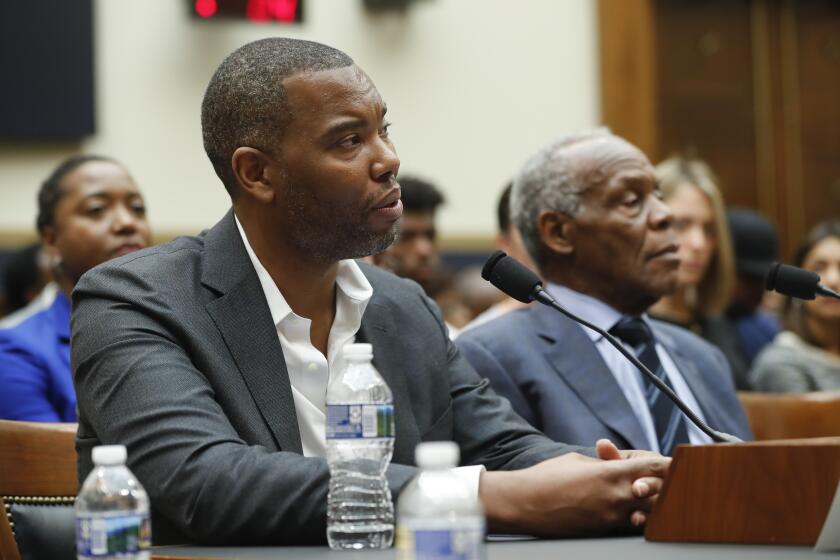Book Review : Is the Sky Still the Limit for U.S. Space Program?
Space: The Next Twenty-Five Years by Thomas R. McDonough (Wiley: $17.95; 228 pages)
Knowledge comes in three types: knowledge for survival, knowledge for achievement and knowledge for pleasure.
The U.S. space program contributes to all three, and it may well be the only government activity that does. It clearly generates knowledge for achievement. Until the Challenger accident a year and a half ago, the National Aeronautics and Space Administration had racked up one achievement after another. Moon landings, reusable spaceships, satellite rescues, global communications, explorations of other worlds--the list is long and very impressive.
The space program also clearly generates knowledge for pleasure. Much of the impetus behind space science, at least, involves answering questions about the origin and development of the universe, which is nice to know even if it has little practical use. The pictures of other planets sent back by unmanned spaceships have a stunning impact beyond their purely scientific use. The excitement of the first landing on the moon went well beyond the prospect of retrieving moon rocks.
Living Elsewhere
And what of knowledge for survival? Thomas R. McDonough, an engineer at Caltech, argues that once humanity learns how to live permanently elsewhere in the universe, “Even the destruction of a planet will not annihilate our species. We will continue to move on to other planets and moons, to asteroids and comets, and gradually we will bridge the gulf between the stars.”
This statement appears in the penultimate paragraph of McDonough’s book, “Space: The Next Twenty-Five Years,” a quick survey of where the U.S. civilian space program has been and where it might go. This is a very timely subject. Important decisions about the future of the space program are in the offing, and the book should help clarify the issues involved.
Since the Challenger accident, the space program has been in shambles, with decision-making on hold. Planning for the space station continues, even as its cost keeps going up and NASA continues to scale back its scope. So far, the space station is sizing up as a rerun of the shuttle: It will cost more and do less than advertised, and years from now study commissions will look back and ask how all this happened.
McDonough lays out all of the options for NASA’s near-term future. In the realm of manned spaceflight, there is the space station, there is a permanent lunar base and there is a voyage to Mars. Each of the possibilities has its advocates, and each has its drawbacks. NASA has yet to commit itself either to the moon or to Mars.
Some space scientists argue that NASA’s continued emphasis on manned spaceflight does not leave enough money for their ambitious plans for the unmanned exploration of the solar system and the universe. This is the part of the space program that is knowledge for pleasure, and it’s the part of the space program that has gone begging as NASA has plowed billions into the shuttle.
McDonough describes the ingenious ideas that have been advanced for planetary and interstellar exploration. They whet the imagination, but, as McDonough notes, it would be a mistake to abandon manned spaceflight in order to pay for the unmanned probes.
Astronauts are needed in space not just to keep Congress and the public interested. No robot has yet been invented or envisioned that can do what people can do. No robot can deal creatively with new and unexpected situations.
“Had Columbus been programmed like a computer, he would have stopped and returned a failure after his calculations indicated he should have seen land but did not,” McDonough writes. “He would not have discovered America.”
Similarly, “Darwin did not set out to discover evolution when he journeyed forth on the Beagle. His intention was simply to observe the animal and plant life of new lands. He could never have guessed--nor could a committee of scientific experts--that in the process of cataloguing all the plants, animals, and fossil rocks he found, he would put these clues together into a theory that would revolutionize biology.”
Exploration is inherently serendipitous, and people can respond to novelty in a way that computers and robots cannot. People and robots both have crucial roles to play in space.
But space exploration is expensive, and the country cannot afford to do everything it wants to. Important choices have to be made, and they have to be made by policy-makers and an informed public. These are not engineering decisions, though technology is vital to their success. These decisions--as most important decisions--have to be made on the basis of judgment and instinct and in the face of incomplete information.
McDonough has done a service in compiling the information that is known and describing the foreseeable outcomes of the various options. The space program still has a lot of life in it. It will come back from the Challenger disaster, but what direction it will go in remains to be decided.
It is still the case, as McDonough makes clear, that humanity’s noblest aspirations and deepest yearnings rest with the space agency. He also makes clear that it must choose wisely what it will do next.
More to Read
Sign up for our Book Club newsletter
Get the latest news, events and more from the Los Angeles Times Book Club, and help us get L.A. reading and talking.
You may occasionally receive promotional content from the Los Angeles Times.






